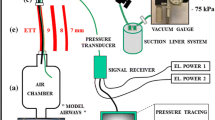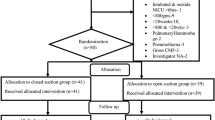Abstract
Objective
This paper aims to highlight the physical principles of pressure and flow dynamics underlying endotracheal suctioning, to demonstrate these on a simple illustrative model and to discuss the clinical implications of these principles for paediatric practice.
Design
Prospective in vitro study.
Setting
Paediatric intensive care unit of a tertiary, academic hospital.
Measurements and main results
The peak pressure change (ΔP) obtained in a “bag-in-box” model was recorded during suctioning, using different combinations of endotracheal tube (ETT) and catheter sizes, different suction pressures and techniques. Suction was also performed on three different consistencies of gelatine, using a range of suction catheter sizes and vacuum pressures. The mass of gelatine suctioned per second was calculated. A large ΔP was measured when using neonatal-sized ETTs. There was a linear relationship (r=0,8, p<0.05) between ΔP and the ratio of external catheter area to area difference (internal ETT area−external catheter area). Significantly greater ΔP was measured when using a short versus long suction catheter (p<0.001) and when applying suction for longer duration (p<0,001) and with higher vacuum pressures (p<0.05). The amount of mucus suctioned in a given time was related to catheter size, suction pressure and mucus density.
Conclusion
Applied clinically, these results indicate that intrapulmonary pressure changes generated by the endotracheal suctioning of intubated neonates are likely to be considerable, possibly translating into loss of lung volume.



Similar content being viewed by others
References
Arai T, Hatano Y, Komatsu K, Takda T, Miyake C, Harioka T, Reshad K (1985) Real-time analysis of the change in arterial oxygen tension during endotracheal suction with a fibreoptic bronchoscope. Crit Care Med 13:855–858
Bailey C, Kattwinkel J, Teja K, Buckley T (1988) Shallow versus deep endotracheal suctioning in young rabbits: pathologic effects on the tracheobronchial wall. Pediatrics 82:746–751
Barker DP, Rutter N (1995) Exposure to invasive procedures in neonatal intensive care unit admissions. Arch Dis Child Fetal Neonatal Ed 72:F47–48
Cabal L, Devaskar S, Siass B, Plajstek C, Waffarn F, Blanco C, Hodgman J (1979) New endotracheal tube adaptor reducing cardiopulmonary effects of suctioning. Crit Care Med 7:552–555
Carhuapoma JR, Williams MA (1999) Endotracheal suctioning and cerebral ischaemia in traumatic brain injury: The “phantom menace”? Crit Care Med27:2843–2844
Darlow DA, Sluis KB, Inder TE, Winterbourn CC (1997) Endotracheal suctioning of the neonate: comparison of two methods as a source of mucus material for research. Pediatr Pulmonol 23:217–221
Durand M, Sangha B, Cabal LA, Hoppenbrouwers T, Hodgman JC (1989) Cardiopulmonary and intracranial pressure changes related to endotracheal suctioning in preterm infants. Crit Care Med 17:506–510
Fanconi S, Duc G (1987) Intratracheal suctioning in sick preterm infants: prevention of intracranial hypertension and cerebral hypoperfusion by muscle paralysis. Pediatrics 79:538–543
Graff M, France J, Hiatt M, Hegyi T(1987) Prevention of hypoxia and hyperoxia during endotracheal suctioning. Crit Care Med 15:1133–1135
Gunderson LP, McPhee AJ, Donovan EF (1986) Partially ventilated endotracheal suction. Use in newborns with respiratory distress syndrome. Am J Dis Child 140:462–465
Kerr ME, Weber BB, Sereika SM, Darby J, Marion DW, Orndoff PA (1999) Effect of endotracheal suctioning on cerebral oxygenation in traumatic brain—injured patients. Crit Care Med 27:2776–2781
Loubser MD, Mahoney PJ, Milligan DW (1989) Hazards of routine endotracheal suction in the neonatal unit. Lancet:1444–1445
Monaco FJ, Meredith KS, A Bench (1992) Test evaluation of a neonatal closed tracheal suction system. Pediatr Pulmonol 13:121–123
Murdoch DR, Darlow BA (1984) Handling during neonatal intensive care. Arch Dis Child 59:957–961
Segar JL, Merrill DC, Chapleau MW, Robillard JE (1993) Hemodynamic changes during endotracheal suctioning are mediated by increased autonomic activity. Pediatr Res 33:649–652
Shah AR, Kurth CP, Gwiazdowski SG, Chance B, Delivoria, Papadopoulos M (1992) Fluctuations in cerebral oxygenation and blood volume during endotracheal suctioning in premature infants. J. Pediatr 120:769–774
Simbruner G, Coradello H, Foder M, Havelec L, Lubec G, Pollak A (1981) Effect of tracheal suction on oxygenation, circulation and lung mechanics in newborn infants. Arch Dis Child 56:326–330
Skov L, Ryding J, Pryds O, Greisen G (1992) Changes in cerebral oxygenation and cerebral blood volume during endotracheal suctioning in ventilated neonates. Acta Paediatr 81:389–393
Tarno-Mordi W (1991) Is routine endotracheal suction justified? Arch Dis Child 66:374–375
Zmora E, Merritt T (1980) Use of side-hole endotracheal tube adaptor for tracheal aspiration. A controlled study. Am J Dis Child 134:250–254
Ehrhart IC, Hofman WF, Loveland SR (1981) Effects of endotracheal suction versus apnoea during interruption of intermittent or continuous positive pressure ventilation. Crit Care Med 9:464–468
Kuzenski B (1978) Effect of negative pressure on tracheobronchial trauma. Nurs Res 27:260–263
Anderson KD, Chandra R (1976) Pneumothorax secondary to perforation of sequential bronchi by suction catheters. J. Pediatr Surg 11:687–693
Rosen M, Hillard EK (1962) Effects of negative pressure during tracheal suction. Anesth Analg 41:50
Boothroyd AE, Murthy BVS, Darbyshire A, Petros AJ (1996) Endotracheal suctioning causes right upper lobe collapse in intubated children. Acta Paediatr 85:1422–1425
Young CS (1984) Recommended guidelines for suction. Physiotherapy 70:106–108
Shann F (1998) Drug doses. 10th edn (1998) Collective Pty, USA
Black-Payne C (1993) Bronchiolitis. In: Hilman BC (ed) Pediatric respiratory disease: diagnosis and treatment. Saunders, Philadelphia p 208
Stocks J, Marchal F, Kraemer R, Gutkowski P, Yishay EP, Godfrey, S (1996) Plethysmographic assessment of functional residual capacity and airway resistance. In: Stocks J, Sly P, Tepper R, Morgan W (eds) Infant respiratory function testing. Wiley-Liss, Canada, p 196
Hodge D (1991) Endotracheal suctioning and the infant: a nursing care protocol to decrease complications. Neonatal Network 9:7–15. Cited in Young J (1995) To help or hinder: endotracheal suction and the intubated neonate. J Neonat Nurs 7:23–28
Kacmarek RM, Stoller JK (1995) Principles of respiratory care. In: Shoemaker WC, Ayres SM, Grenvik A, Holbrook P (eds) Textbook of critical care. 3rd edn. Saunders, Philadelphia, p 695
Bethune DW, Collis JM, Wotherspoon CM (1971) Endotracheal suction. Anaesthesia 26:527–529
Dyhr T, Bonde J, Larsson A (2003) Lung recruitment manoeuvres are effective in regaining lung volume and oxygenation after open endotracheal suctioning in acute respiratory distress syndrome. Crit Care 7:55–62
Hipenbecker DL, Guthrie MM (1981) The effects of negative pressure generated during endotracheal suctioning on lung volumes and pulmonary compliance. Am Rev Respir Dis 123:120
Polacek L, Guthrie MM (1981) The effect of suction catheter size and suction flow rate on negative airway pressure and its relationship to the fall in arterial oxygen tension. Am Rev Respir Dis 123:120
Branson RD, Campbell RS, Chatburn RL, Covington JC (1993) AARC clinical practice guideline: endotracheal suctioning of mechanically ventilated adults and children with artificial airways. Respir Care 38:500–504
Brandstater B, Muallem M (1969) Atelectasis following tracheal suction in infants. Anesthesiology 31:468–473
Acknowledgements
We thank Lance Howell for technical support.
Author information
Authors and Affiliations
Corresponding author
Additional information
This work was supported by research grants from Institute of Child Health (University of Cape Town) and South African Physiotherapy Research Foundation. Consumables were funded by EMS – VEN Medical (RSA).
Rights and permissions
About this article
Cite this article
Morrow, B.M., Futter, M.J. & Argent, A.C. Endotracheal suctioning: from principles to practice. Intensive Care Med 30, 1167–1174 (2004). https://doi.org/10.1007/s00134-004-2238-0
Received:
Accepted:
Published:
Issue Date:
DOI: https://doi.org/10.1007/s00134-004-2238-0




